seats MAZDA MODEL 3 HATCHBACK 2021 Owner's Manual
[x] Cancel search | Manufacturer: MAZDA, Model Year: 2021, Model line: MODEL 3 HATCHBACK, Model: MAZDA MODEL 3 HATCHBACK 2021Pages: 612, PDF Size: 89.06 MB
Page 34 of 612
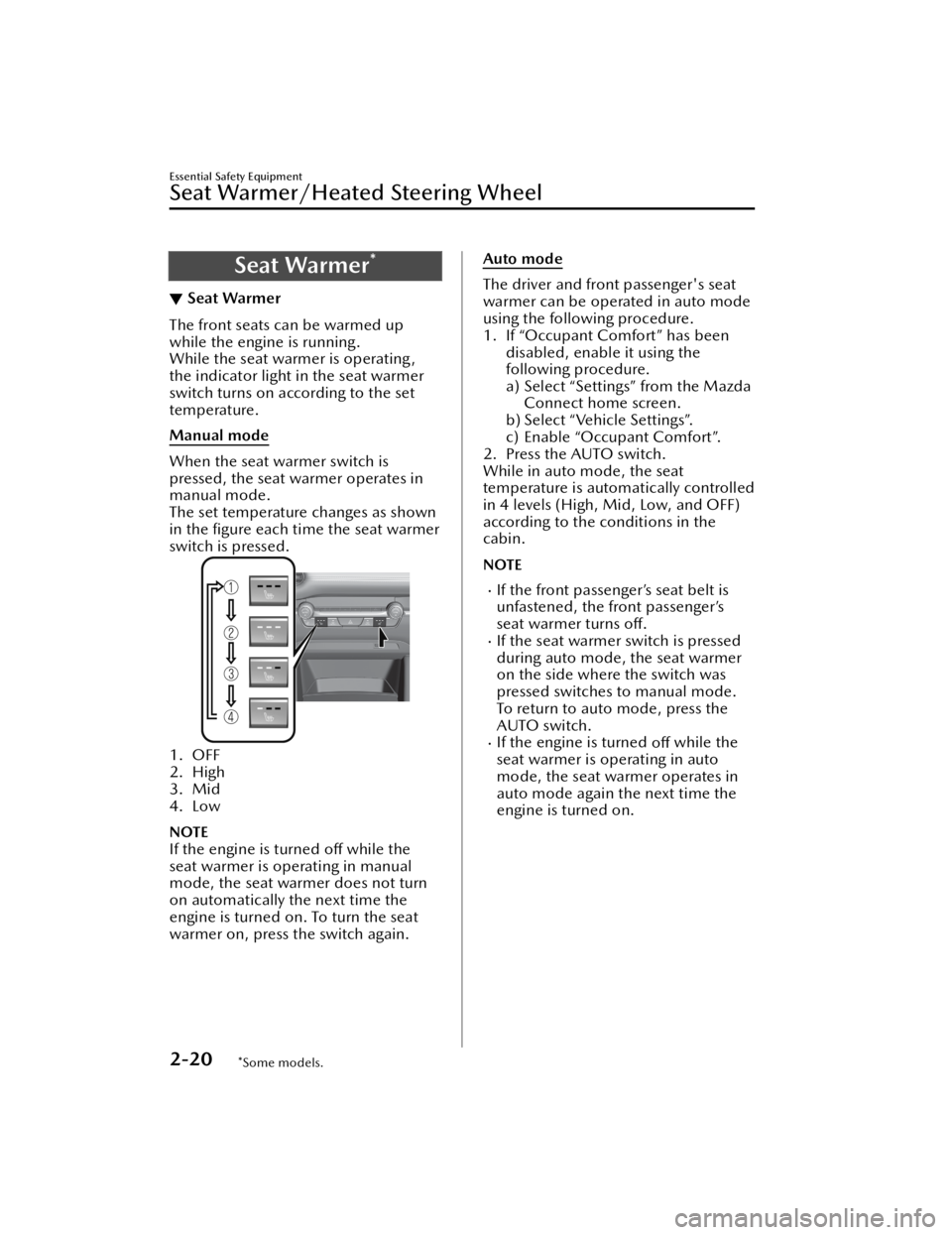
Seat Warmer*
▼Seat Warmer
The front seats can be warmed up
while the engine is running.
While the seat warmer is operating,
the indicator light in the seat warmer
switch turns on according to the set
temperature.
Manual mode
When the seat warmer switch is
pressed, the seat warmer operates in
manual mode.
The set temperature changes as shown
in the
figure each time the seat warmer
switch is pressed.
1. OFF
2. High
3. Mid
4. Low
NOTE
If the engine is turned off while the
seat warmer is operating in manual
mode, the seat warmer does not turn
on automatically the next time the
engine is turned on. To turn the seat
warmer on, press the switch again.
Auto mode
The driver and front passenger's seat
warmer can be operated in auto mode
using the following procedure.
1. If “Occupant Comfort” has been disabled, enable it using the
following procedure.
a) Select “Settings” from the MazdaConnect home screen.
b) Select “Vehicle Settings”.
c) Enable “Occupant Comfort”.
2. Press the AUTO switch.
While in auto mode, the seat
temperature is automatically controlled
in 4 levels (High, Mid, Low, and OFF)
according to the conditions in the
cabin.
NOTE
If the front passenger’s seat belt is
unfastened, the front passenger’s
seat warmer turns off.
If the seat warmer switch is pressed
during auto mode, the seat warmer
on the side where the switch was
pressed switches to manual mode.
To return to auto mode, press the
AUTO switch.
If the engine is turned
off while the
seat warmer is operating in auto
mode, the seat warmer operates in
auto mode again the next time the
engine is turned on.
Essential Safety Equipment
Seat Warmer/Heated Steering Wheel
2-20*Some models.
Mazda3_8JM2-EA -20H_Edition1_new 2020-7-10 17:21:34
Page 37 of 612

Seat Belt Precautions
▼Seat Belt Precautions
Seat belts help to decrease the
possibility of severe injury during
accidents and sudden stops. Mazda
recommends that the driver and all
passengers always wear seat belts.
(Mexico)
All the seats have lap/shoulder belts.
These belts have retractors with inertia
locks that keep them out of the way
when not in use. The locks allow the
belts to remain comfortable on users,
but they will lock in position during a
collision.
(Except Mexico)
All of the seat belt retractors are
designed to keep the lap/shoulder
belts out of the way when not in use.
The driver's seat belt has no provisions
for child-restraint systems and has only
an emergency locking mode. The
driver may wear it comfortably, and it
will lock during a collision.
However, the front passenger's seat
and all rear lap/shoulder belt
retractors operate in two modes:
emergency locking mode, and for
child-restraint systems, automatic
locking mode. While we recommend
you put all children in the rear seats, if
you must use the front passenger seat
for a child, slide the front passenger
seat as far back as possible and make
sure any child-restraint system is
secured properly.
WARNING
Always wear your seat belt and make
sure all occupants are properly
restrained:
Not wearing a seat belt is extremely
dangerous. During a collision,
occupants not wearing seat belts could
hit someone or things inside the
vehicle or even be thrown out of the
vehicle. They could be seriously injured
or even killed. In the same collision,
occupants wearing seat belts would be
much safer.
Do not wear twisted seat belts:
Twisted seat belts are dangerous. In a
collision, the full width of the belt is
not available to absorb the impact.
This puts more force on the bones
beneath the belt, which could cause
serious injury or death. So, if your seat
belt is twisted, you must straighten the
seat belt to remove any twists and to
allow the full width of the belt to be
used.
Never use one seat belt on more than
one person at a time:
Using one seat belt for more than one
person at a time is dangerous. A seat
belt used in this way cannot spread the
impact forces properly and the two
passengers could be crushed together
and seriously injured or even killed.
Never use one belt for more than one
person at a time and always operate
the vehicle with each occupant
properly restrained.
Essential Safety Equipment
Seat Belt Systems
2-23
Mazda3_8JM2-EA
-20H_Edition1_new 2020-7-10 17:21:34
Page 46 of 612
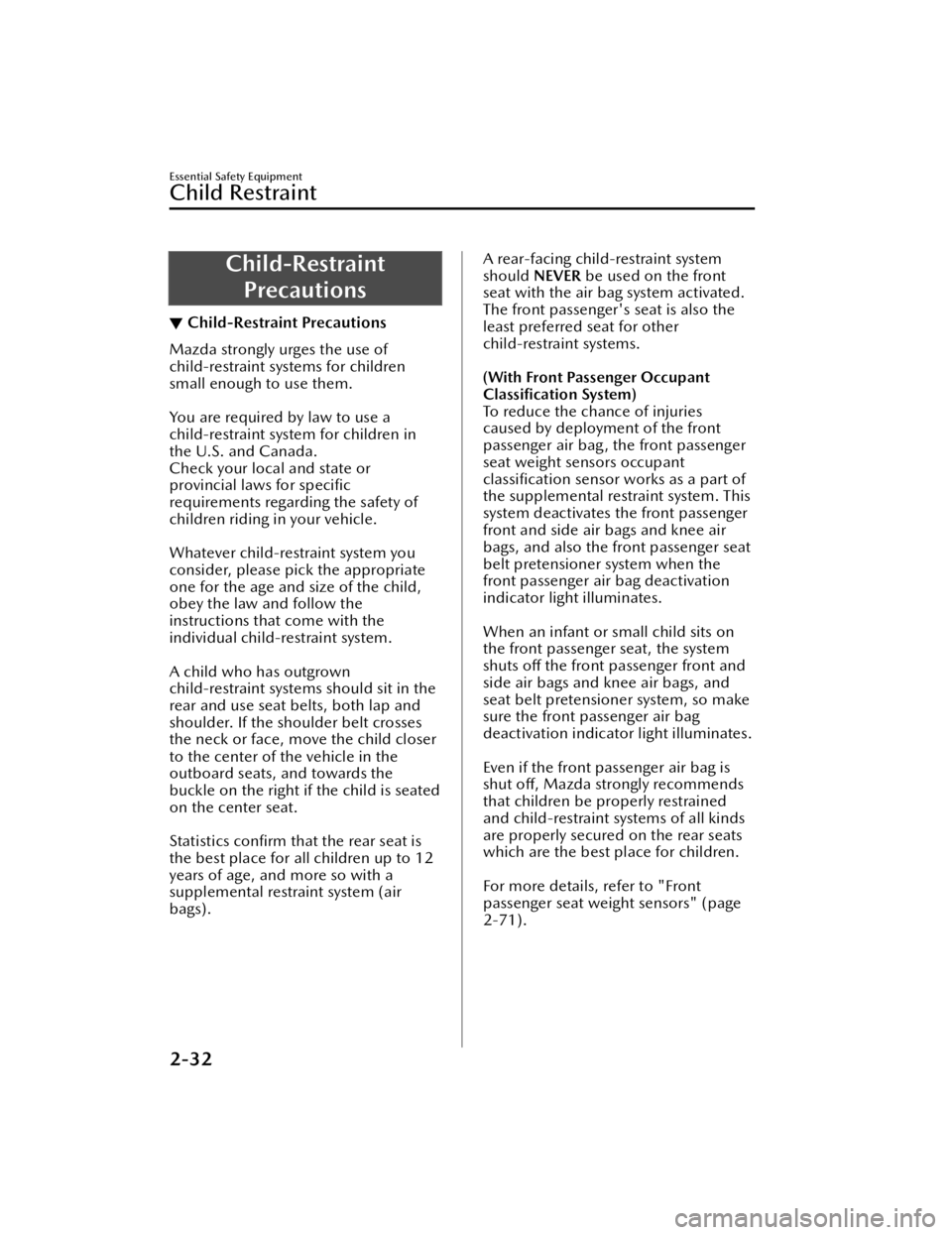
Child-RestraintPrecautions
▼ Child-Restraint Precautions
Mazda strongly urges the use of
child-restraint systems for children
small enough to use them.
You are required by law to use a
child-restraint system for children in
the U.S. and Canada.
Check your local and state or
provincial laws for speci
fic
requirements regarding the safety of
children riding in your vehicle.
Whatever child-restraint system you
consider, please pick the appropriate
one for the age and size of the child,
obey the law and follow the
instructions that come with the
individual child-restraint system.
A child who has outgrown
child-restraint systems should sit in the
rear and use seat belts, both lap and
shoulder. If the shoulder belt crosses
the neck or face, move the child closer
to the center of the vehicle in the
outboard seats, and towards the
buckle on the right if the child is seated
on the center seat.
Statistics con firm that the rear seat is
the best place for all children up to 12
years of age, and more so with a
supplemental restraint system (air
bags).
A rear-facing child-restraint system
should NEVER be used on the front
seat with the air bag system activated.
The front passenger's seat is also the
least preferred seat for other
child-restraint systems.
(With Front Passenger Occupant
Classi fication System)
To reduce the chance of injuries
caused by deployment of the front
passenger air bag, the front passenger
seat weight sensors occupant
classi fication sensor works as a part of
the supplemental restraint system. This
system deactivates the front passenger
front and side air bags and knee air
bags, and also the front passenger seat
belt pretensioner system when the
front passenger air bag deactivation
indicator light illuminates.
When an infant or small child sits on
the front passenger seat, the system
shuts o ff the front passenger front and
side air bags and knee air bags, and
seat belt pretensioner system, so make
sure the front passenger air bag
deactivation indicator light illuminates.
Even if the front passenger air bag is
shut o ff, Mazda strongly recommends
that children be properly restrained
and child-restraint systems of all kinds
are properly secured on the rear seats
which are the best place for children.
For more details, refer to "Front
passenger seat weight sensors" (page
2-71).
Essential Safety Equipment
Child Restraint
2-32
Mazda3_8JM2-EA -20H_Edition1_new 2020-7-10 17:21:34
Page 49 of 612
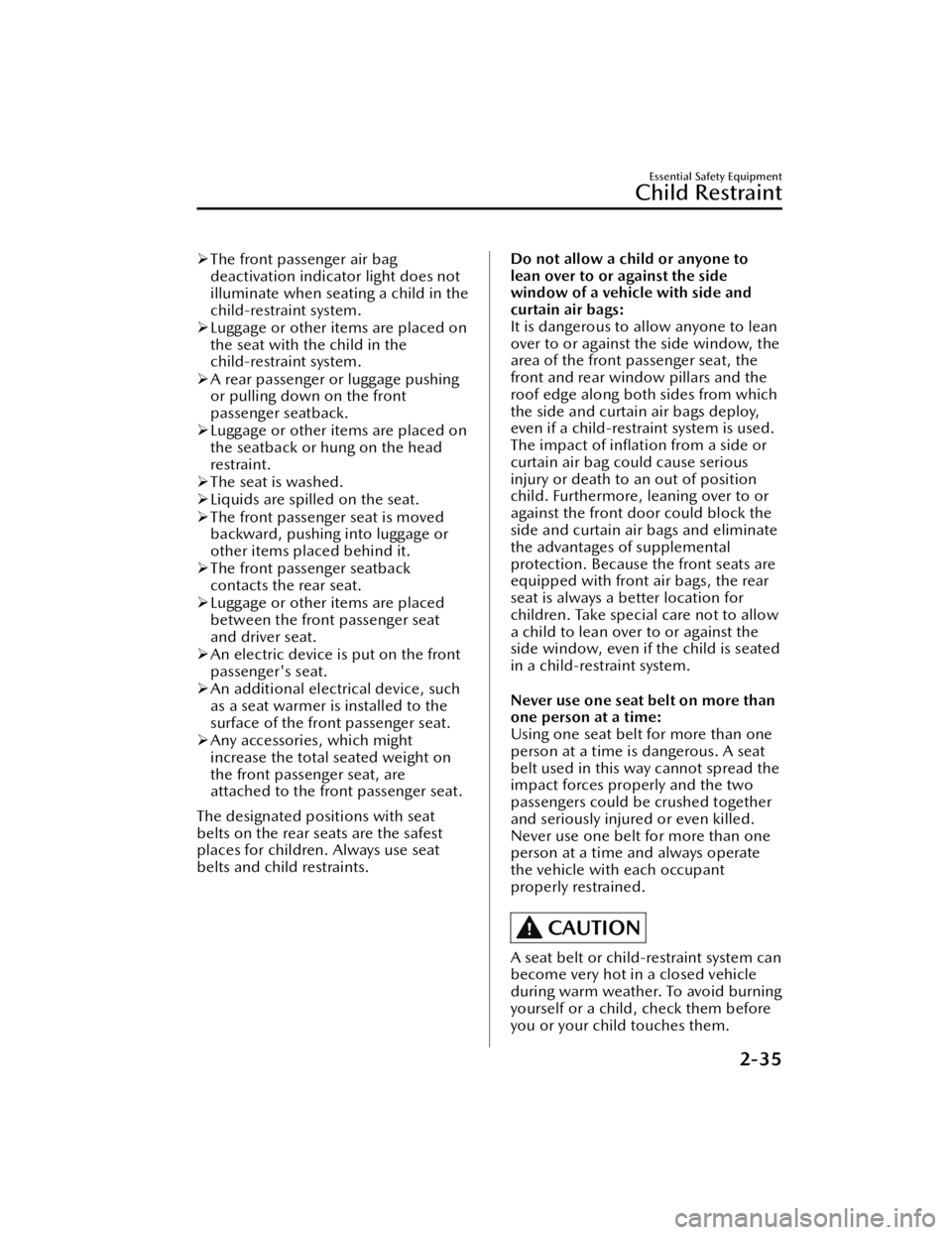
The front passenger air bag
deactivation indicator light does not
illuminate when seating a child in the
child-restraint system.
Luggage or other items are placed on
the seat with the child in the
child-restraint system.
A rear passenger or luggage pushing
or pulling down on the front
passenger seatback.
Luggage or other items are placed on
the seatback or hung on the head
restraint.
The seat is washed.
Liquids are spilled on the seat.
The front passenger seat is moved
backward, pushing into luggage or
other items placed behind it.
The front passenger seatback
contacts the rear seat.
Luggage or other items are placed
between the front passenger seat
and driver seat.
An electric device is put on the front
passenger's seat.
An additional electrical device, such
as a seat warmer is installed to the
surface of the front passenger seat.
Any accessories, which might
increase the total seated weight on
the front passenger seat, are
attached to the front passenger seat.
The designated positions with seat
belts on the rear seats are the safest
places for children. Always use seat
belts and child restraints.Do not allow a child or anyone to
lean over to or against the side
window of a vehicle with side and
curtain air bags:
It is dangerous to allow anyone to lean
over to or against the side window, the
area of the front passenger seat, the
front and rear window pillars and the
roof edge along both sides from which
the side and curtain air bags deploy,
even if a child-restraint system is used.
The impact of in flation from a side or
curtain air bag could cause serious
injury or death to an out of position
child. Furthermore, leaning over to or
against the front door could block the
side and curtain air bags and eliminate
the advantages of supplemental
protection. Because the front seats are
equipped with fron t air bags, the rear
seat is always a better location for
children. Take special care not to allow
a child to lean over to or against the
side window, even if the child is seated
in a child-restraint system.
Never use one seat belt on more than
one person at a time:
Using one seat belt for more than one
person at a time is dangerous. A seat
belt used in this way cannot spread the
impact forces properly and the two
passengers could be crushed together
and seriously injured or even killed.
Never use one belt for more than one
person at a time and always operate
the vehicle with each occupant
properly restrained.
CAUTION
A seat belt or child-restraint system can
become very hot in a closed vehicle
during warm weather. To avoid burning
yourself or a child, check them before
you or your child touches them.
Essential Safety Equipment
Child Restraint
2-35
Mazda3_8JM2-EA -20H_Edition1_new 2020-7-10 17:21:34
Page 50 of 612

NOTE
Your Mazda is equipped with ISOFIX/
LATCH*1 lower anchors for attachment
of specially designed ISOFIX/LATCH*1
child-restraint systems on the rear
seats. When using these anchors to
secure a child-restraint system, refer to
"Using ISOFIX Lower Anchor
(Mexico)/Using LATCH Lower Anchor
(Except Mexico)" (page 2-50).
*1 ISOFIX (Mexico)/LATCH (Except Mexico)
Essential Safety Equipment
Child Restraint
2-36
Mazda3_8JM2-EA -20H_Edition1_new 2020-7-10 17:21:34
Page 52 of 612
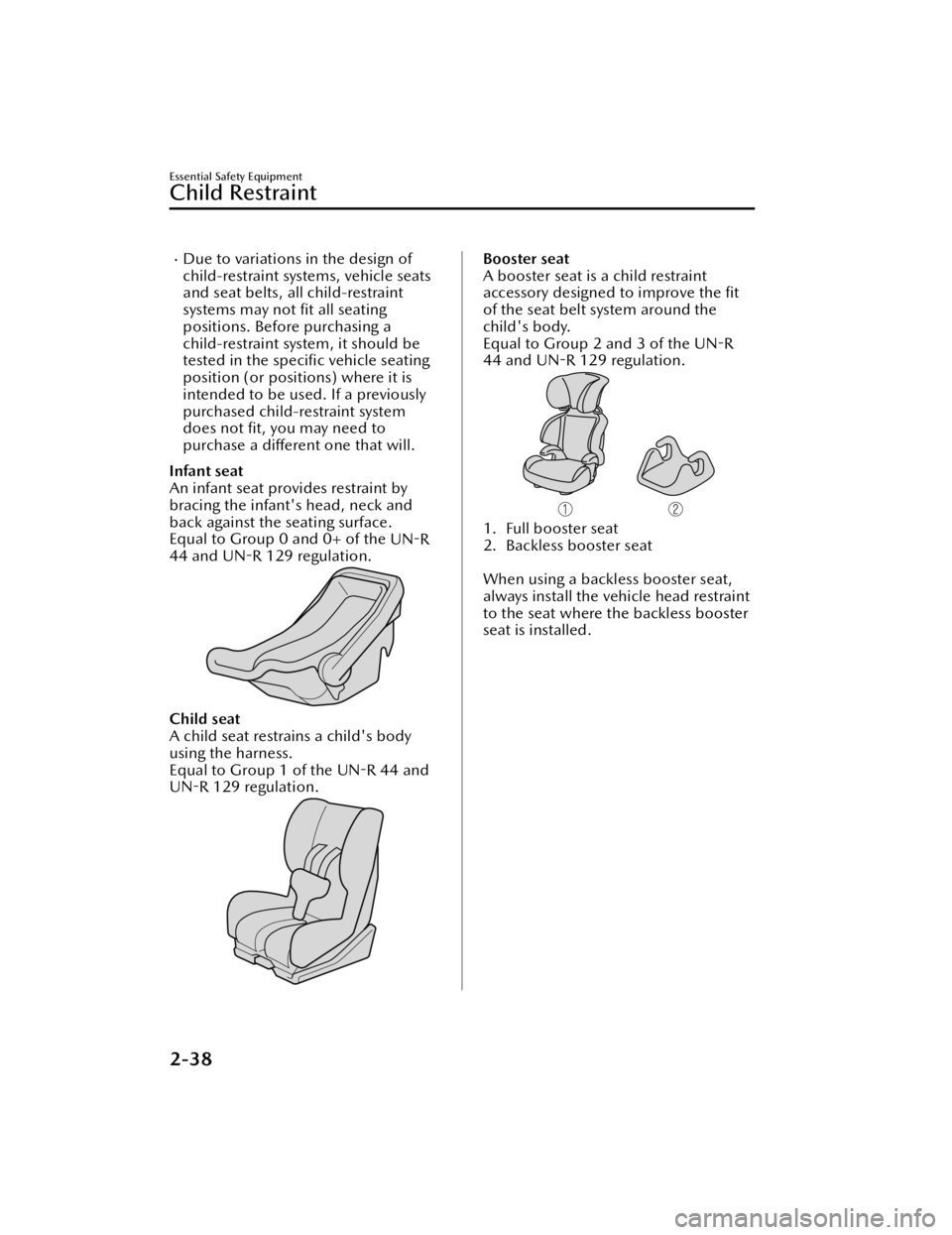
Due to variations in the design of
child-restraint systems, vehicle seats
and seat belts, all child-restraint
systems may not fit all seating
positions. Before purchasing a
child-restraint system, it should be
tested in the speci fic vehicle seating
position (or positions) where it is
intended to be used. If a previously
purchased child-restraint system
does not fit, you may need to
purchase a di fferent one that will.
Infant seat
An infant seat provides restraint by
bracing the infant's head, neck and
back against the seating surface.
Equal to Group 0 and 0+ of the UN-R
44 and UN -R 129 regulation.
Child seat
A child seat restrains a child's body
using the harness.
Equal to Group 1 of the UN -R 44 and
UN -R 129 regulation.
Booster seat
A booster seat is a child restraint
accessory designed to improve the fit
of the seat belt system around the
child's body.
Equal to Group 2 and 3 of the UN -R
44 and UN -R 129 regulation.
1. Full booster seat
2. Backless booster seat
When using a backless booster seat,
always install the vehicle head restraint
to the seat where the backless booster
seat is installed.
Essential Safety Equipment
Child Restraint
2-38
Mazda3_8JM2-EA -20H_Edition1_new 2020-7-10 17:21:34
Page 56 of 612

Installing Child-RestraintSystems
▼Installing Child-Restraint Systems
Accident statistics reveal that a child is
safer in the rear seat. The front
passenger's seat is clearly the worst
choice for any child under 12, and
with rear-facing child-restraint systems
it is clearly unsafe due to air bags.
NOTE
Even if your vehicle is equipped with
front passenger occupant classi
fication
sensor (page 2-71), which
automatically deactivates the front
passenger air bag , a rear seat is the
safest place for a child of any age or
size.
Some child-restraint systems now
come with tethers and therefore must
be installed on the seats that take
tethers to be e ffective. In your Mazda,
tethered child-restraint systems can
only be accommodated in the three
positions on the rear seat.
Some child-restraint systems also
employ specially designed ISOFIX/
LATCH
*1 attachments; refer to "Using
ISOFIX Lower Anchor (Mexico)/Using
LATCH Lower Anchor (Except
Mexico)" (page 2-50).
*1 ISOFIX (Mexico)/LATCH (Except Mexico)
WARNING
Tethered Child-Restraint Systems
Work Only on Tether-Equipped Rear
Seats:
Installation of a tether equipped
child-restraint system in the front
passenger's seat defeats the safety
design of the system and will result in
an increased chance of serious injury if
the child-restraint system goes forward
without benefit of being tethered.
Place tether equipped child-restraint
systems where there are tether
anchors.
▼ Anchor Bracket
Anchor brackets for securing
child-restraint systems are equipped in
the vehicle. Locate each anchor
position using the illustration.
To install a child-restraint system,
remove the head restraint. Always
follow the instruction manual
accompanying the child-restraint
system.
Anchor bracket location
Use the indicated anchor bracket
locations when installing a
child-restraint system equipped with a
tether.
(4–Door)
1. For right
2. For center (Except Mexico)
3. For left
Essential Safety Equipment
Child Restraint
2-42
Mazda3_8JM2-EA
-20H_Edition1_new 2020-7-10 17:21:34
Page 61 of 612
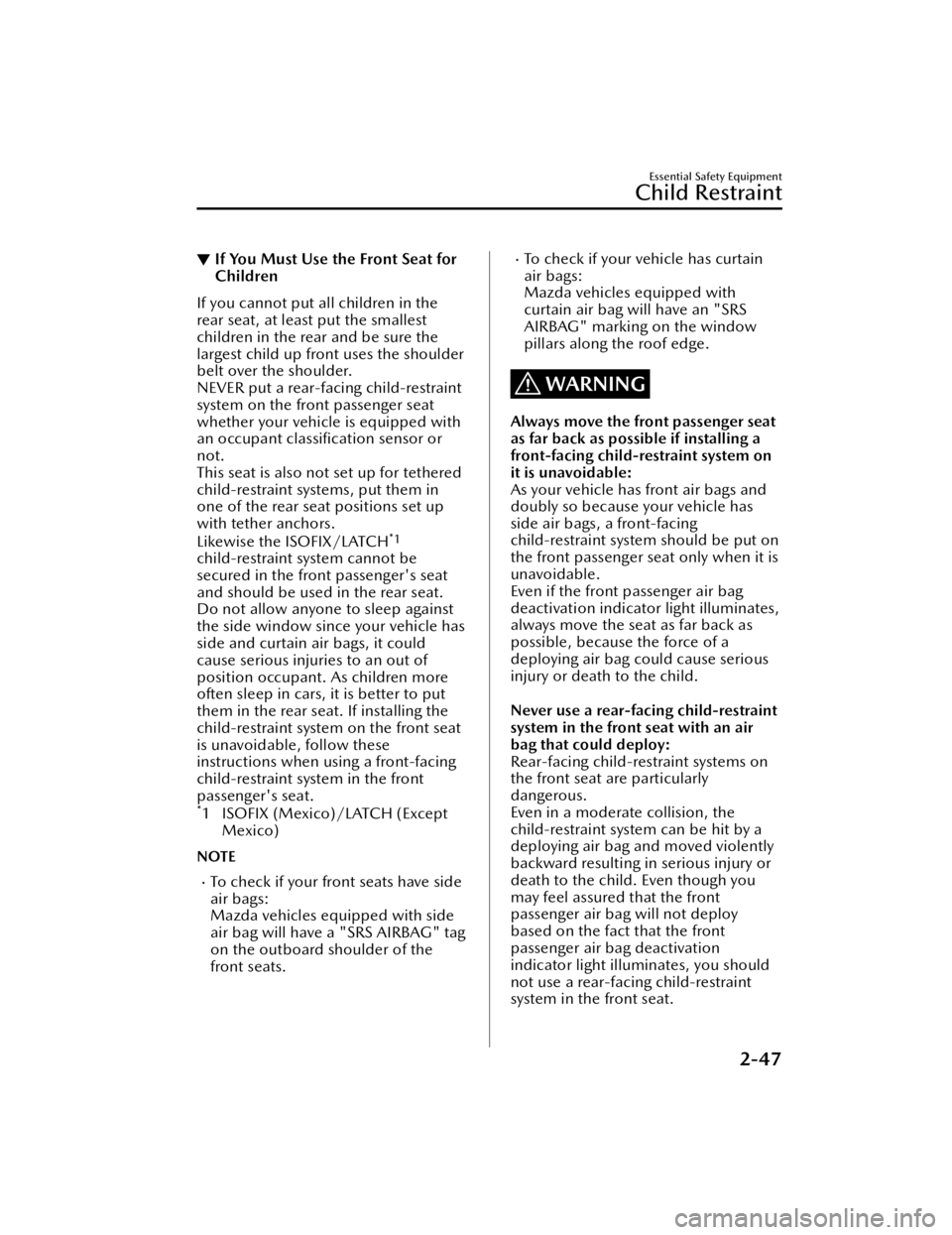
▼If You Must Use the Front Seat for
Children
If you cannot put all children in the
rear seat, at least put the smallest
children in the rear and be sure the
largest child up front uses the shoulder
belt over the shoulder.
NEVER put a rear-facing child-restraint
system on the front passenger seat
whether your vehicle is equipped with
an occupant classi
fication sensor or
not.
This seat is also not set up for tethered
child-restraint systems, put them in
one of the rear seat positions set up
with tether anchors.
Likewise the ISOFIX/LATCH
*1
child-restraint system cannot be
secured in the front passenger's seat
and should be used in the rear seat.
Do not allow anyone to sleep against
the side window since your vehicle has
side and curtain air bags, it could
cause serious injuries to an out of
position occupant. As children more
often sleep in cars, it is better to put
them in the rear seat. If installing the
child-restraint system on the front seat
is unavoidable, follow these
instructions when using a front-facing
child-restraint system in the front
passenger's seat.
*1 ISOFIX (Mexico)/LATCH (Except Mexico)
NOTE
To check if your front seats have side
air bags:
Mazda vehicles equipped with side
air bag will have a "SRS AIRBAG" tag
on the outboard shoulder of the
front seats.
To check if your vehicle has curtain
air bags:
Mazda vehicles equipped with
curtain air bag will have an "SRS
AIRBAG" marking on the window
pillars along the roof edge.
WARNING
Always move the front passenger seat
as far back as possible if installing a
front-facing child-restraint system on
it is unavoidable:
As your vehicle has front air bags and
doubly so because your vehicle has
side air bags, a front-facing
child-restraint system should be put on
the front passenger seat only when it is
unavoidable.
Even if the front passenger air bag
deactivation indicator light illuminates,
always move the seat as far back as
possible, because the force of a
deploying air bag could cause serious
injury or death to the child.
Never use a rear-facing child-restraint
system in the front seat with an air
bag that could deploy:
Rear-facing child-restraint systems on
the front seat are particularly
dangerous.
Even in a moderate collision, the
child-restraint system can be hit by a
deploying air bag and moved violently
backward resulting in serious injury or
death to the child. Even though you
may feel assured that the front
passenger air bag will not deploy
based on the fact that the front
passenger air bag deactivation
indicator light illuminates, you should
not use a rear-facing child-restraint
system in the front seat.
Essential Safety Equipment
Child Restraint
2-47
Mazda3_8JM2-EA -20H_Edition1_new 2020-7-10 17:21:34
Page 62 of 612
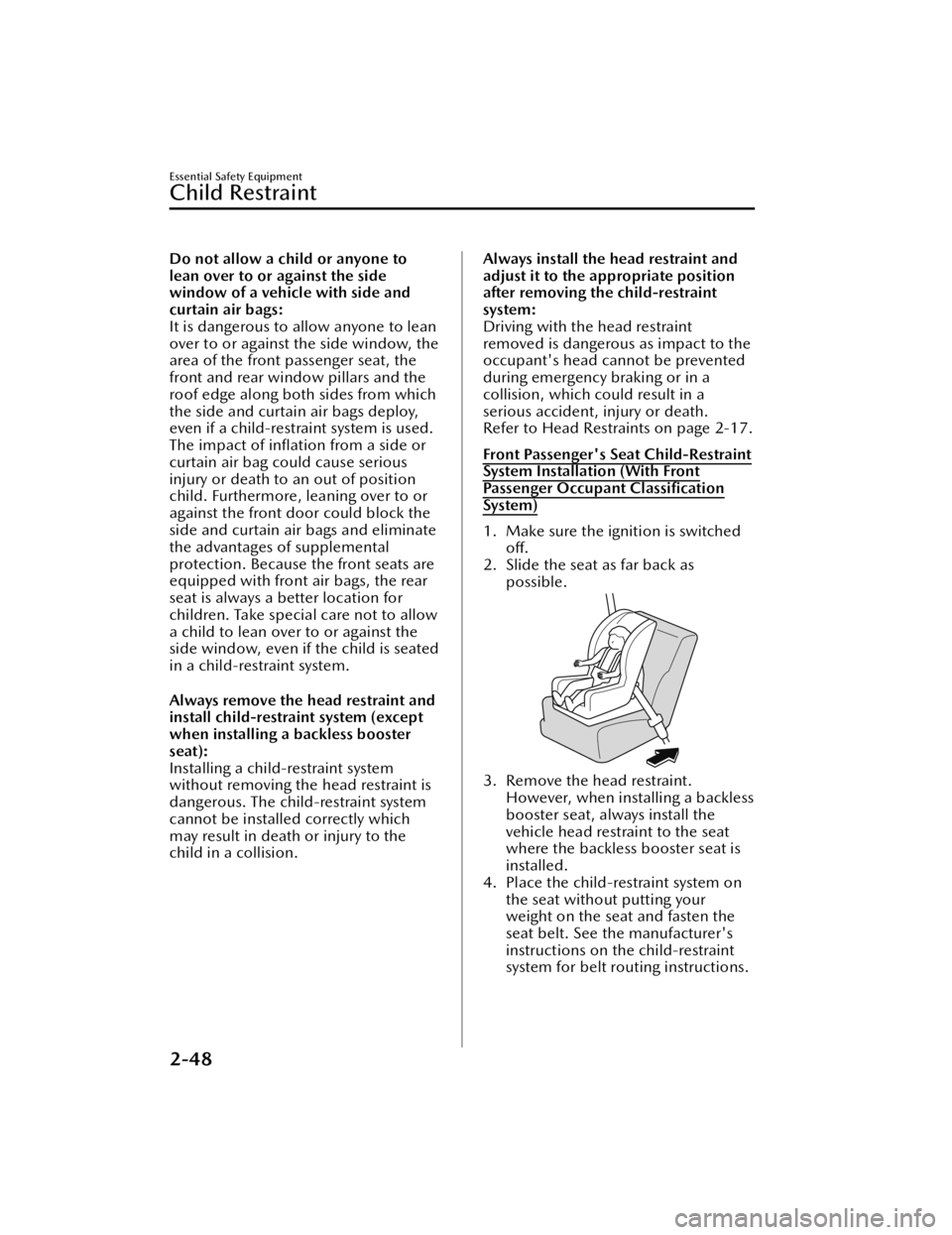
Do not allow a child or anyone to
lean over to or against the side
window of a vehicle with side and
curtain air bags:
It is dangerous to allow anyone to lean
over to or against the side window, the
area of the front passenger seat, the
front and rear window pillars and the
roof edge along both sides from which
the side and curtain air bags deploy,
even if a child-restraint system is used.
The impact of inflation from a side or
curtain air bag could cause serious
injury or death to an out of position
child. Furthermore, leaning over to or
against the front door could block the
side and curtain air bags and eliminate
the advantages of supplemental
protection. Because the front seats are
equipped with fron t air bags, the rear
seat is always a better location for
children. Take special care not to allow
a child to lean over to or against the
side window, even if the child is seated
in a child-restraint system.
Always remove the head restraint and
install child-restraint system (except
when installing a backless booster
seat):
Installing a child-restraint system
without removing the head restraint is
dangerous. The child-restraint system
cannot be installed correctly which
may result in death or injury to the
child in a collision.Always install the head restraint and
adjust it to the appropriate position
after removing the child-restraint
system:
Driving with the head restraint
removed is dangerous as impact to the
occupant's head cannot be prevented
during emergency braking or in a
collision, which could result in a
serious accident, injury or death.
Refer to Head Restraints on page 2-17.
Front Passenger's Seat Child-Restraint
System Installation (With Front
Pa s s e n g e r O cc u p a n t Classification
System)
1. Make sure the ignition is switched
off.
2. Slide the seat as far back as possible.
3. Remove the head restraint.However, when installing a backless
booster seat, always install the
vehicle head restraint to the seat
where the backless booster seat is
installed.
4. Place the child-restraint system on
the seat without putting your
weight on the seat and fasten the
seat belt. See the manufacturer's
instructions on the child-restraint
system for belt routing instructions.
Essential Safety Equipment
Child Restraint
2-48
Mazda3_8JM2-EA -20H_Edition1_new 2020-7-10 17:21:34
Page 64 of 612
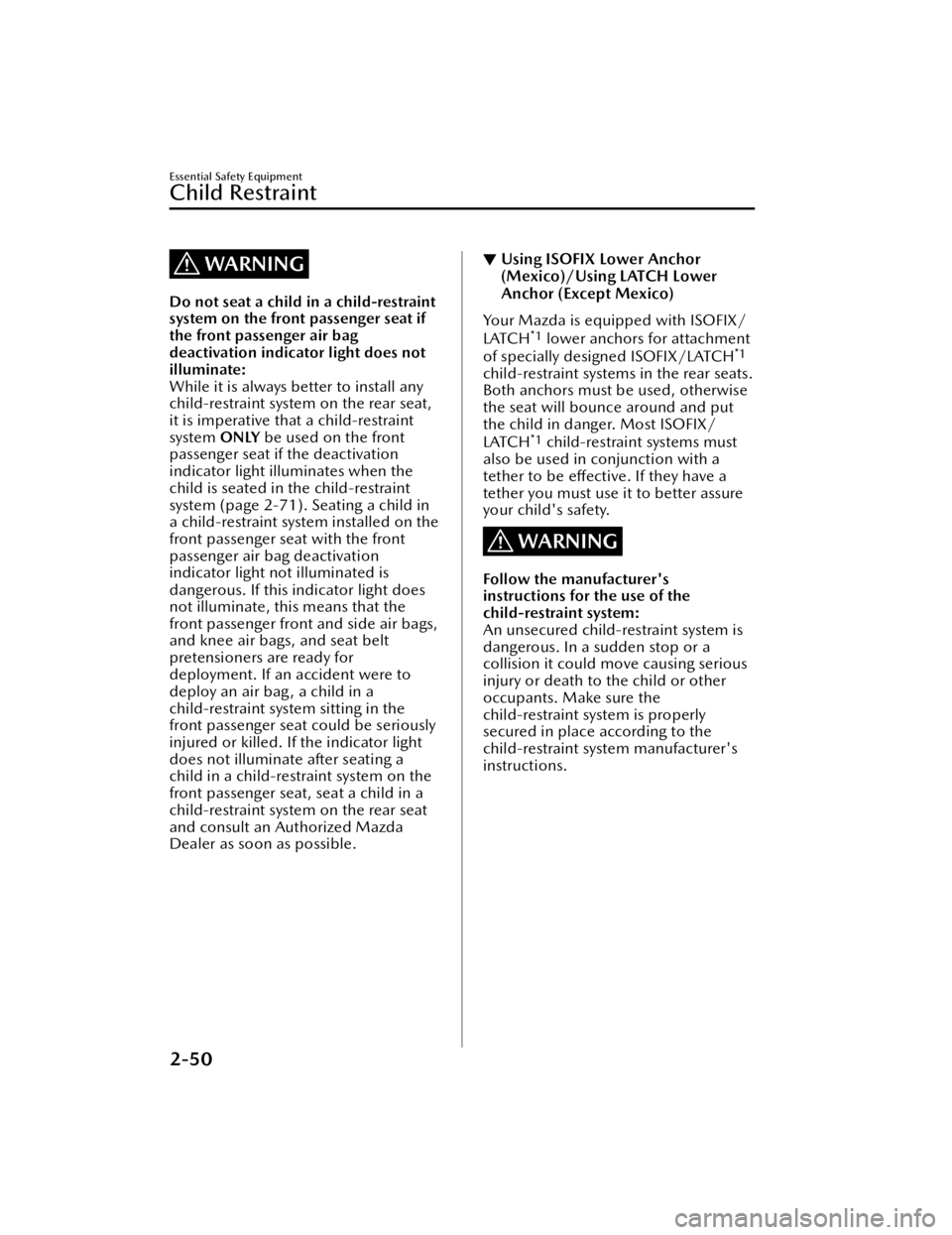
WARNING
Do not seat a child in a child-restraint
system on the front passenger seat if
the front passenger air bag
deactivation indicator light does not
illuminate:
While it is always better to install any
child-restraint system on the rear seat,
it is imperative that a child-restraint
system ONLY be used on the front
passenger seat if the deactivation
indicator light illuminates when the
child is seated in the child-restraint
system (page 2-71). Seating a child in
a child-restraint system installed on the
front passenger seat with the front
passenger air bag deactivation
indicator light not illuminated is
dangerous. If this indicator light does
not illuminate, this means that the
front passenger front and side air bags,
and knee air bags, and seat belt
pretensioners are ready for
deployment. If an accident were to
deploy an air bag, a child in a
child-restraint system sitting in the
front passenger seat could be seriously
injured or killed. If the indicator light
does not illuminate after seating a
child in a child-restraint system on the
front passenger seat, seat a child in a
child-restraint system on the rear seat
and consult an Authorized Mazda
Dealer as soon as possible.
▼ Using ISOFIX Lower Anchor
(Mexico)/Using LATCH Lower
Anchor (Except Mexico)
Your Mazda is equipped with ISOFIX/
LATCH*1 lower anchors for attachment
of specially designed ISOFIX/LATCH*1
child-restraint systems in the rear seats.
Both anchors must be used, otherwise
the seat will bounce around and put
the child in danger. Most ISOFIX/
LATCH
*1 child-restraint systems must
also be used in conjunction with a
tether to be e ffective. If they have a
tether you must use it to better assure
your child's safety.
WARNING
Follow the manufacturer's
instructions for the use of the
child-restraint system:
An unsecured child-restraint system is
dangerous. In a sudden stop or a
collision it could move causing serious
injury or death to the child or other
occupants. Make sure the
child-restraint system is properly
secured in place according to the
child-restraint system manufacturer's
instructions.
Essential Safety Equipment
Child Restraint
2-50
Mazda3_8JM2-EA -20H_Edition1_new 2020-7-10 17:21:34